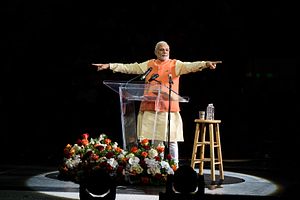Narendra Modi’s rise to the office of Indian prime minister represents a decisive break from past politics. A challenge to the Nehru-Gandhi dynasty – which has dominated the Indian political landscape for more than six decades – was long overdue; that it comes from Narendra Modi, an outsider to the entire New Delhi political establishment, makes it even more profound. The Indian political class has failed to match the aspirations of a rapidly changing India, and Narendra Modi has managed to fill that vacuum. Under Modi, India got its first genuinely center-right government.
One of the most talented politicians in the country, Modi has experienced a political rise that is nothing short of extraordinary. He received a resounding mandate from the Indian electorate, based largely on his agenda of good governance and economic development. The implications of that mandate are still being felt, not simply domestically in India where he has managed to change the political discourse considerably, but on the global stage where the Indian story has once again become attractive.
Economic Optimism
Only a few months ago India was described as the “most disappointing” of the BRIC nations. Its economic reform program had lost traction under a weak and inept government and the Indian rupee was one of the worst-performing currencies among emerging markets. Global credit rating agencies were threatening to downgrade India’s sovereign credit rating to junk if it failed to put its fiscal house in order. In early 2011, the Indian economy was expanding at more than 9 percent. The intervening years have been marked by a sharp slowdown, with growth dropping to 4.7 in the fiscal year that ended in March 2014. Today, the Indian stock market is booming, growth has surged and there is widespread optimism about India’s future. India is now the only one of the BRIC states expected to expand at a faster rate this year than last. More than $16 billion has been poured into Indian stocks this year alone. The Indian equity indices have outperformed other emerging markets so far this year as well. The rupee is currently the best-performing currency among major emerging markets. Not all of this is due to Modi’s policies, but a new government with a decisive mandate has altered global perceptions about India’s potential.
Modi has unveiled an ambitious policy agenda that aims to control inflation, build infrastructure, and speed up investments. India’s unpredictable and capricious tax system has been one of the most significant obstacles to investment. The UPA-II government tried to confiscate profits by making new tax regulations retroactive, which had a predictably dire impact on domestic and foreign investment. The Modi government has promised “rationalization and simplification of the tax regime to make it non-adversarial and conducive to investment, enterprise and growth.” In its first budget presented in July 2014, the new government focused on infrastructure development, streamlining of subsidies, and easing restrictions on foreign investment. Though it was seen as lacking in ambition, two aspects in particular – an increase in foreign investment in the insurance and defense sectors – have been widely welcomed.

































